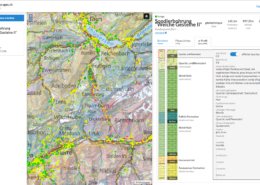Where public transport is lacking, on-demand driving services step in
No train station, no bus station nearby? No reason to get into your own car. On-demand services close this gap to public transport. Such on-demand services were the topic of the latest <a href="https://www.mobilservice.ch/de/agenda/webinare/webinar-on-demand-2445.html">webinar of the mobility platform mobilservice.Energeiaplus uses <a href="https://mybuxi.ch/">mybuxi as an example to show how this works. The on-demand ride service is currently on the road in the Oberaargau/Emmental area. There are innovations for mobility professionals on the mobitool and trafikguide platforms (see box at the end of the text).
In <a href="https://mybuxi.ch/regionen/herzogenbuchsee-niederoenz/">Herzogenbuchsee, it all started with mybuxi at the end of April 2019. The Oberaargau municipality and its neighbour Niederönz were too small for a classic local bus line, and the taxi service had given up. Nevertheless, there was to be a service for the 8000 residents.
The municipal council of Herzogenbuchsee approved 90,000 Swiss francs for a two-year pilot operation with a so-called call bus. Theproject also received support from the regional electricity supplier EWK Herzogenbuchsee, from a private foundation and from <a href="http://www.energieschweiz.ch/komo">KOMO, the federal government's "Coordination Office for Sustainable Mobility".
The Ruf bus runs 7 days a week from the first to the last train, about 18 hours a day. The difference to the regular bus: mybuxi runs there and then, when it is needed.
Around 3000 people use the service each month, and by the end of February 2021 the total number of passengers had risen to around 40,000. At the wheel are volunteer drivers who transport passengers in one of the two e-minibuses between the station and home or in town. Practically every house in Herzogenbuchsee and Niederönz has its own stop on the doorstep.
Incidentally, the name mybuxi refers to the mix between bus and taxi and is also a tribute to the pilot community of Herzogenbuchsee, or Buchsi as the locals say. Meanwhile, mybuxi still operates in other regions, since 2020 in the <a href="https://mybuxi.ch/regionen/emmental/">Emmental. In addition, the driving service has also established cooperations with companies and businesses there, for example with the Emmental show dairy or the Emmental hospital.
Until the end of March 2021, mybuxi was also on the road on the outskirts of Bern in a trial. However,because there were too few passengers, the service was discontinued in<a href="https://mybuxi.ch/regionen/ostermundigen-stettlen/">Ostermundigen, Stettlen and Bolligen. Following the Corona pandemic, a review will be carried out to see whether services can be resumed in this region with a modified offer.
Andreas Kronawitter is the managing director and co-initiator of mybuxi. Energeiaplus wanted to know from him whether such offers are really a substitute for one's own car. And what they achieve - also in terms of sustainability and energy efficiency.
Energeiaplus: mybuxi wants to be an alternative to owning a car. What do you find? Does mybuxi contribute to people needing their own car less?
Andreas Kronawitter: We know from some people, especially older people, that they have given up their cars. For a real change in behavior, however, a service has to be on the market for a very long time and be available across the board
Who uses your service? What is your customer segment?
When we start in an area, our first passengers are mostly seniors and the young. The middle age groups follow later. Women use mybuxi faster and more than men. The broad mix of customer segments means that mybuxi is used very evenly from early morning to late at night. Since the pandemic, however, we have been driving people mainly to work and to the doctor; other activities are hardly possible
How does a service like mybuxi contribute to energy-efficient mobility?
According to our experience so far, especially from Herzogenbuchsee, one mybuxi can already replace journeys of 30-50 private cars per day. By improving the service, we want to increase this figure even further. Of course, these cars will not disappear overnight. For this to happen, such a service must be offered nationwide and in the long term. In the medium term, this will save the grey energy required for the production and scrapping of these vehicles.
On the other hand, we save energy for driving: because journeys can be combined, the mybuxi requires less energy per passenger
Such on-demand services can also be seen as a driver of urban sprawl. What do you say to this?
Driving to every single house makes no economic sense in sprawling areas like the Emmental. Even with the mybuxi we will not serve 100% of the population. However, we are more likely to be confronted with the opposite problem: Communities turn to us to prevent migration from the established village structures. Young families in particular are moving from the village to the agglomerations - the cities are usually too expensive. In the agglomeration, however, few do without a car
In Emmental or Herzogenbuchsee, the mybuxi call-bus system has established itself, but in the Bernese suburban communities of Ostermundigen, Stettlen and Bolligen you have discontinued operations. The aim was to open up remote parts of the villages with the on-demand service. Why does mybuxi work in one place and not in another?
There are probably several reasons: In our survey, it was often mentioned that the Bern-Wankdorf S-Bahn station was not in the perimeter. On the other hand, there is a dense public transport network and short distances, especially in Ostermundigen, and in Stettlen and Bolligen the motorization of the inhabitants is very high. And we felt the homeworking during Corona much more strongly on the outskirts than in Emmental. Incidentally, the mybuxi was best used to and from the outlying districts.
Postauto has been operating such call buses for some time. The Zürcher Verkehrsbetriebe have also had an on-demand service since November. These are both companies with a concession that otherwise offer scheduled services. What distinguishes these services from mybuxi?
With mybuxi, we are not going into the cities.There, public transport and taxisare more efficient than an on-demand service can be. Individual niches like Pikmi (in Zurich) can make sense as a supplement, but there is always the danger that subsidised services will compete with private taxi providers.
PostBus's Publicar service is more comparable to mybuxi. These call buses from PostBus have also been on the road in rural areas for some time
Our long-term goal is to ensure that the costs of mobility are kept to a minimum. Therefore we are critical of subsidized offers. We want to develop the optimal mobility offer for our users as well as for the companies of a region; a "monopoly protection" by concessions is very obstructive for innovations. And the procedures are very slow: we need to make much faster progress in the mobility sector with regard to climate change
We are aiming for a nationwide service in combination with public transport with mybuxi. We hope to achieve this in fruitful competition with players such as PostBus. Today, 75% of people travel by car, so the potential is large enough. However, it would be absurd and, above all, expensive if each of the 250 licensed transport companies wanted to set up its own on-demand service
The Coordination Office for Sustainable Mobility (KOMO) selects the most promising projects for support from 30-50 applications each year. Question to Claudia Heer, head of KOMO, Why was mybuxi in particular considered?
Mybuxi is not "only" about piloting an on-demand service, but also about testing and comparing it in different areas - from the agglomeration (Ostermundigen), to a regional centre (Herzogenbuchsee), to very rural communities (Emmental) - all of which have different social, economic and traffic conditions. This provides additional insights into the framework conditions under which on-demand services can be operated successfully.
- What is the importance of on-demand services from KOMO's point of view?
KOMO is looking for new, sustainable mobility solutions. We see great potential in multimodal approaches, i.e. meaningful mobility that is adapted to the situation and can be combined. Services such as myBuxi can make a meaningful contribution here, as a supplement and feeder to public transport or as a substitute for journeys by car.
Box 1: I would layout as a box pretty much at the top of the text.
The on-demand webinar is one of a series of online events launched by<a href="https://www.mobilservice.ch/">Mobilservice. Mobilservice is the platform for sustainable mobility and mobility management. The topic of the next webinar on June 15, 2021: "Bike Streets - Right of Way for Bicycles in Cities and Municipalities". To register, go <a href="https://www.mobilservice.ch/de/agenda/webinare/webinar-velostrassen-2520.html">here.
Box 2
News from mobitool - the platform for mobility management tools and environmental data
"<a href="https://www.mobitool.ch/de/tools/mobitool-faktoren-v2-1-25.html">mobitool.ch" is the Swiss platform for mobility management tools and processed environmental data. mobitool offers a selection of useful information and tools for the mobility management process as well as for calculating energy efficiency and environmental impact. At the beginning of 2021, two significant adjustments have been made to mobitool.ch:
- Update of the "<a href="https://www.mobitool.ch/de/tools/mobitool-faktoren-v2-1-25.html">mobitool factors". These are the emission and environmental values of more than 150 means of transport, which aresummarised in an <a href="https://www.mobitool.ch/admin/data/files/tool/tool_file_de/5/mobitool-faktoren-v2.1.xlsm?lm=1613033947">Excel fileand are available free of charge as a data basis for life cycle assessments, for comparisons of means of transport, for modelling etc.
- The "<a href="https://www.mobitool.ch/de/tools/trafikguide-67.html">Trafikguide ": this guide categorizes and describes mobility solutions. It is the first comprehensive collection of existing and innovative mobility offerings. With the update planned in April, the <a href="http://www.trafik.guide/">Trafikguide alreadydescribes 400 services, from home and abroad, such as mobility sharing offers, on-demand offers, cargo platforms.
 mybuxi
mybuxi
 2 Vote(s), Durchschnitt: 4,50
2 Vote(s), Durchschnitt: 4,50 swisstoposwissforages.ch, la plateforme sur la gestion des données de forage
swisstoposwissforages.ch, la plateforme sur la gestion des données de forage  Swiss Innovation Forum 2014
Swiss Innovation Forum 2014  David OrmerodUn nouveau barrage pour remplacer l’ancien au Grimsel
David OrmerodUn nouveau barrage pour remplacer l’ancien au Grimsel  zvg - Armin MeierEnergiewende und Heimatschutz Hand in Hand
zvg - Armin MeierEnergiewende und Heimatschutz Hand in Hand 
 ETH Zürich
ETH Zürich CKW
CKW
Dein Kommentar
An Diskussion beteiligen?Hinterlassen Sie uns Ihren Kommentar!